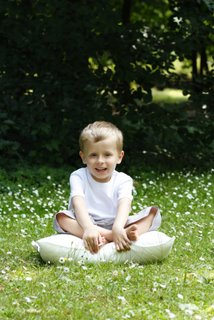
meditation for children
By the age of eight, a child’s fundamental personality has formed and his or her body begins a process of preparing for puberty. Changes begin to occur in children’s brains around the age of eight, and these changes reach a peak during puberty. When we teach meditation to this age group, our main aim is to support balanced physical and mental development. This helps the child be better mentally prepared for the onslaught of feelings, desires, and urges that arise during puberty. It also supports the child’s ability to take in knowledge at school, and to develop a relaxed focus and good memory.
Eight-year-olds in India learn three practices to foster total physical, mental, and spiritual development. These are Sun Salutation for the body, alternate nostril breathing for the brain and mind, and mantras for the deeper mind and spirit. These practices can slow the onset of puberty and balance its effects by acting on the subtle channels that flow in the spine. Mental development then has time to catch up to physical changes.
Yogic physiology explains how this occurs. A child’s physical changes during puberty are under the control of pingala nadi, the spinal channel that carries prana, the life force. Mental development occurs under the control of ida nadi, the spinal channel that carries psychological force. Excessive stimulation of the physical channel alone, as tends to occur in the normal social environment, causes imbalanced development and can make puberty a rough process. The yogic practices taught children at this time stimulate both channels equally, to stimulate physical and mental growth at the same time.
The practice of Sun Salutation balances the life force, prana, preventing it from becoming jammed up in the sexual centers (swadhisthana chakra). One note of caution is to teach children only asanas that are playful and that do not put too much pressure on the endocrine system. Never hold the major poses for extended periods, as they will overstimulate the physical systems and can cause imbalanced development.
Alternate nostril breathing is a pre-meditative practice that balances the flow of energy in both ida and pingala. This pranayama directly affects the physical and mental systems by balancing both sides of the brain. Do not teach breath retention to children. Simply get them to observe the flow of the breath in on one side and out on the other, alternating sides. This will calm and balance them.
Mantras are the main meditative practices taught to this age group, as they powerfully affect the brain and its development. The main mantra taught is the Gayatri mantra. This mantra has 24 syllables, each of which stimulates a different part of the brain. Gayatri is the mantra to stimulate our intelligence.
All of the practices listed above, including yoga nidra as detailed for younger children, will support a child’s ability to learn, to take in and digest information at school, and to develop individual interests.
adapted from Yoga Journal by Swami Shankardev Saraswati, Ph.D.

Maple Meditation Timer with Chime
Now & Zen
1638 Pearl Street
Boulder, CO 80302
(800) 779-6383
Posted in yoga, Yoga Timer, Yoga Timers by Now & Zen